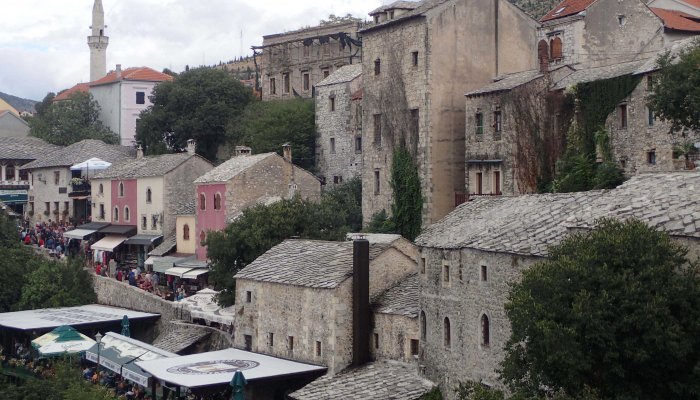When Haris Delibasić offered to show “Professor Sam” a cave near his home in Visoko, 40km northwest of Sarajevo in 2006, little did he know how his personal paradigm would shift.
First, he learnt the hills framing his village were, in fact, four vegetation-covered, 30,000-year-old pyramids with an exact zero-degree North orientation. Then, the cave turned out to be the entrance to the “world’s most extensive underground network of tunnels”.
Professor “Sam” Semir Osmanagić, head of Bosnia-Herzegovina’s American University’s Anthropology Department and author of 15 books on ancient civilizations, discovered the Visoko pyramids in 2005 and knew the tunnels were there … somewhere.
“When I showed him the cave, he started excavations the next day and more tunnels emerged within 72 hours of clearing,” recalls Delibasić, senior guide at the dig, now in its 11th year. Delibasić believes the tunnels could stretch for hundreds of kilometres.
“An advanced civilization with technology far superior to anything we have today, built these tunnels within a single generation by hollowing out the post-glacial conglomerate for 3.8km in eight directions – linking the Sun, Moon, Love, and Dragon pyramids. After digging out the tunnels, they added pebbles, quartz crystal, and limestone to the excavated conglomerate to build the pyramids,” he says.
We are sitting in the Ravne tunnel network’s “healing chamber” ‒ 2.5 km from the Sun pyramid, which at 220 metres, is a third higher than Egypt’s Great Pyramid of Giza. Indeed, the Visoko valley’s ancient name was Egipat, which means Egypt.
Earlier, my husband and I had climbed the Sun pyramid, which affords a great view of Visoko below. The massive concrete blocks that cover all sides beneath the vegetation looked impressive. Independent analysis from five European universities confirms the material is five times stronger and more resistant to water than any man-made concrete today.
I’m feeling ever so rejuvenated thanks to all the negative ions generated by an egg-shaped 8000kg monolith – one of three – found in the chamber. Analysis by the Institute for Nuclear Physics in Zagreb proved the 35 000-year-old quartz monolith covered in man-made ceramic, generates ultra-sound frequencies and magnetic energies. Varying ceiling heights further circulate the airflow throughout the network of tunnels.
Comments Delibasić: “No way were pyramids used as burial places. The ancients, who knew the secrets of frequency, used pyramid energy to advance human health, so it can’t ever have been a place for dead people.”
An ultrasound beam with a 10-metre radius and 28-33 kHz frequency has been measured coming from the top of the Sun pyramid. Says Delibasić: “This would have made it the Earth’s biggest antenna but the tunnels were filled in with soft sand around 4600 years ago, effectively putting the pyramid on “standby” with just 3% of its capacity. Perhaps this was to prevent the technology falling into the wrong hands.”
Mainstream scientists can scoff if they like. The Bosnian government intends to keep digging.
It Mostar Be Love!
Just inland from the Adriatic coast in the southern part of Bosnia-Herzegovina, a crossroads of cultures defines this beleaguered city
Edin “Pelko” Pelkovic recalls 9 November 1993 – the day the Serbians bombed Mostar’s medieval Stari Most Bridge into the River Neretva – like it happened yesterday. “I’m not ashamed to say I wept like a baby. I think every Bosnian alive cried that day.”
It’s understandable when you consider that the Old Bridge – constructed on the orders of Sultan Suleiman the Magnificent – dated back to 1566.
The swooping stone arch of the original walkway was rebuilt in 2004 from rubble hauled out of the river, and declared a UNESCO World Heritage site in Durban on July 17 2005. (Durbs hey, who knew?)
Today, daredevil divers fling themselves off the Stari Most parapet, dropping 20m into the Neretva’s icy waters for thrills, chills, and cash. You thought bungee jumpers were brave? Pah!
The road to Mostar is paved with narrow hairpin bends flanked by shrines and random stalls selling honey, homegrown tobacco, and vegetables. With more mountains than Switzerland and a burgeoning wine industry – ironic for a Muslim country, but that’s Bosnia-Herzegovina for you – the views change from castle ruins to bombed out farmhouses, fruit trees, tunnels, rivers and streams.
Refined by the minarets of many mosques rising like middle-fingered salutes to the Serbians, Mostar lurks in a birch-forested valley. Across the river, twice the length of the tallest minaret, stands the Croats’ new Catholic Church spire. And on the hilltop high above the town, a cross heralds what feels to me like an uneasy truce, but time will tell.
Orthodox Serbs, Catholic Croats, and Muslim Bosniaks lived here in seeming harmony before war broke out in 1992. Croats and Bosniaks forced out the Serbs before turning their guns on each other and the city became a killing zone. With pockmarked walls and shells of bombed out buildings such as the once majestic neo-Moorish Hotel Neretva (built in 1892) and the haunting nine-storey concrete skeleton of the former Ljubljanska Banka, most of Mostar looks as though it was kicked in the teeth.
Small cemeteries congested with white-marble tombstones abound. Closer inspection reveals that most died in 1993, 1994, or 1995. According to “Pelko” who lived through the war, snipers would pick off anyone walking down the street – “women, children, they didn’t care”. Sometimes bodies were left rotting for days on end along the main boulevard.
Today, sizzling in the late summer sunshine, the cobbled streets of the medieval Ottoman Old Town seem picture-perfect and peaceful. However, walking shoes are essential. I nearly broke an ankle teetering over the cobbles in high heels.
Here, as in Sarajevo, entrepreneurial coppersmiths have twisted spent ammunition into intricate sculptures and beaten shell casings into pens, sold at many souvenir stalls.
Accommodation varies from backpacker hostels to mediocre hotels but what Mostar lacks in luxury, it makes up for in historical interest, being a sobering snapshot of war’s inhumanity.





















